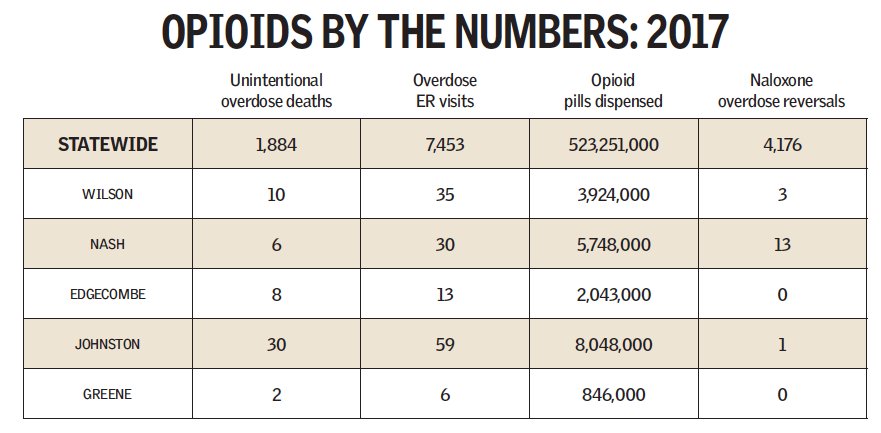
09 Jan Data could show drop in opioid deaths
State officials say North Carolina saw an increase in unintentional opioid-related overdose deaths in 2017 compared to the previous year. And it was due to the increase of potent illicit drugs including heroin and fentanyl.
There were 1,884 unintentional opioid-related overdose deaths in North Carolina in 2017, a 34 percent increase from 2016 where the number came in at 1,407, according to state figures.
But there may be good news for 2018.
State officials say while it’s too early to report final numbers for 2018, preliminary data from the first quarter showed a decrease in opioid-related overdose deaths compared to the fourth quarter of 2017. And provisional data for January to November year-to-date emergency department visits for 2018 are 7 percent lower compared to the same time period in 2017, according to state officials.
“While we are seeing progress in some metrics including emergency room visits, we still have a lot or work to do,” Dr. Mandy K. Cohen, secretary of the N.C. Department of Health and Human Services, said in a recent news release. “We need to close the coverage gap if we are to make serious headway against this epidemic, as they have done in other states.”
In 2017, Wilson County had 10 unintentional opioid overdose deaths and 35 opioid overdose emergency department visits, according to state data.
The state launched an opioid action plan in June 2017, which aims to identify “specific, achievable steps that will have the greatest impact on reducing deaths from the opioid epidemic.” The plan also collects metrics tracking the scope of the crisis.
Wilson County continues to be a leader in the fight against the crisis implementing multiple programs, resources and initiatives. Multiple stakeholders have united in the effort here as well.
PRESCRIPTION OPIOID SUPPLY DECREASES
State officials say the number of opioid pills dispensed statewide decreased by 24 percent from the end of 2016 to the second quarter of 2018.
The rate of patients who received opioids from five or more prescribers dispensed at five more pharmacies decreased more than 70 percent, according to state officials. But opioid overdose deaths involving illicit drugs including heroin, fentanyl or fentanyl analogues increased from 59 percent to 81 percent over the last two years, state figures show.
INCREASE IN NALOXONE AVAILABILITY
More than 1,700 retail pharmacies are dispensing naloxone — a lifesaving antidote that reverses opioid overdoses — under the statewide standing order. That order gives pharmacists the ability to dispense naloxone to anyone who requests it.
The Wilson Police Department and Wilson County Sheriff’s Office are among the nearly 250 law enforcement agencies across the state who carry naloxone. Wilson is also among the 29 syringe exchange programs across the state.
EXPANDED TREATMENT ACCESS AND RECOVERY SUPPORT
State officials say the number of individuals and Medicaid beneficiaries with an opioid-use disorder served by treatment programs increased from 15,282 from the fourth quarter of 2016 to 19,202 from the second quarter of 2018.
During that same time, state officials reported there was a 25 percent increase in the subscription for buprenorphine, a medication-assisted treatment drug used for opioid use disorder.
BY THE NUMBERS
STATEWIDE 2017
• 1,884: total North Carolinians unintentional opioid overdose deaths
• 7,453: total opioid overdose emergency department visits
• 523,251,000: opioid pills dispensed to North Carolina residents
• 4,176: reported community naloxone reversals in North Carolina
WILSON COUNTY 2017
• 10: number of unintentional opioid overdose deaths
• 35: number of opioid overdose emergency department visits
• 3,924,000: number of opioid pills dispensed to Wilson residents
• 3: number of reported community naloxone reversals
NASH COUNTY 2017
• 6: number of unintentional opioid overdose deaths
• 30: number of opioid overdose emergency department visits
• 5,748,000: number of opioid pills dispensed
• 13: number of reported naloxone reversals
JOHNSTON COUNTY 2017
• 30: number unintentional opioid overdose deaths
• 59: number of opioid overdose emergency department visits
• 8,048,000: number of opioid pills dispensed
• 1: number of reported naloxone reversals
GREENE COUNTY 2017
• 2: number of unintentional opioid overdose deaths
• 6: number of opioid overdose emergency department visits
• 846,000: number of opioid pills dispensed
0: number of reported naloxone reversals
EDGECOMBE COUNTY 2017
• 8: number of unintentional opioid overdose deaths
• 13: number of opioid overdose emergency department visits
• 2,043,000: number of opioid pills dispensed
• 0: number of reported naloxone reversals
SOURCE: N.C. Department of Health and Human Services
[ad_2]
Source link



No Comments